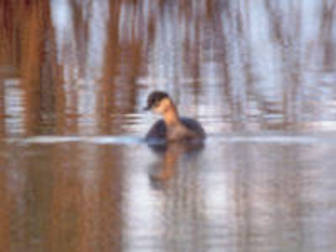Alaotra Grebe
This species declined in the course of the 20th century, mainly due to habitat destruction and predation by introduced snakehead murrel . Also, the few remaining birds increasingly hybridized with Little Grebes which use the wetlands as a migration stopover site; as the species differed in several key aspects, the hybrid birds may have suffered from decreased fitness, to the detriment of the rufolavatus gene pool.

Original source: Paul Thompson
Author: Paul Thompson
The Alaotra Grebe is classified as Critically Endangered (CR), facing an extremely high risk of extinction in the wild.
since the Alaotra grebe genes still exist in the little grebe population, could selective breeding of the most Alaotra-like ones reconcentrate those genes and re-create the Alaotra grebe? Posted by: William Miller | August 31, 2009 2:17 AM 7 The Madagascar pochard looks very much like the ferruginous duck Aythya nyroca. Are they sister taxa? Darren: said to still be common in Soothill & Whitehead's 1978 Wildfowl of the World. More
Alaotra Grebe (Tachybaptus rufolavatus), which is presumed extinct (BI 2000, Morris and Hawkins 1998). No sightings have been made since 1985, when only two birds were seen. It declined from loss of its habitat, hunting and hybridizing with the Little Grebe (Podiceps ruficollis), a recent arrival from Africa (Morris and Hawkins 1998). Many fruitless searches for the species have been carried out in the lake and surrounding area since then (BI 2000, Morris and Hawkins 1998). More
Family : Podicipedidae
Genus : Tachybaptus
Species : rufolavatus
Authority : (Delacour, 1932)
